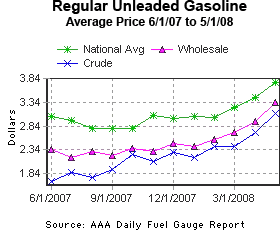
WASHINGTON – The U.S. may be addicted to oil, as President Bush proclaimed in 2006, but a leading scientist says it’s a habit the nation probably could kick.
“Energy independence is a realistic goal for the United State of America,” says David Greene, a corporate fellow at the Oak Ridge National Laboratory, the Department of Energy’s largest science-and-energy research unit.
Greene’s assertion comes as oil prices hover near $130 a barrel, up a factor of more than six times since 1999. Meanwhile, the average U.S. per-gallon price of regular-grade gasoline is approaching $4 per gallon – triple what consumers paid less than 10 years ago.
The national average pump price hit a new record today – $3.95 – according to the American Automobile Assn.
Greene also admits his claim is contrary to opinions outlined in works such as “Gusher of Lies” by energy journalist Robert Bryce, who calls the notion of oil independence “hogwash.”
“What they miss is oil independence does not mean using no oil or importing no oil. It means achieving a state where your consumption actions are not subject to restraining or directly influenced by others as consequence of the need for oil,” Green tells the recent Society of Automotive Engineers’ Government/Industry meeting here.
“Think of it this way: You want your children to leave your home and become successful, but you don’t want to never see them again.”

Greene characterizes U.S. oil dependence as an economic dilemma complicated for years by the lack of a meaningful substitute and a clumsy group of nation states with control over the resource’s supply.
“It is an economic problem,” says Greene, the 2007 recipient of the SAE International’s Barry D. McNutt Award for Excellence in Automotive Policy Analysis. “There are certainly military implications, foreign policy implications, but I assert that those are derivatives of the potential economic impact.
“If our economy didn’t care about oil, our military wouldn’t care about oil. It is a problem that has to do with use of market power by the oil-producing states, how important it is to the U.S. economy, and the fact we lack economical and easy-to-use substitutes for oil.”
Reduce the economy’s reliance on oil, Greene offers, and America might break its $500 billion-a-year addition.
“Make the cost of oil independence to the economy so small it will have no affect on economic, military or foreign policy,” he says.
Greene estimates the U.S. would need to bring the cost of imported oil down to less than 1% of Gross Domestic Product by 2030, or to roughly $200 billion. Ambitious for sure, Greene says, but he draws confidence from recent history and future impact of the Energy Independence and Security Act (EISA) signed into law last year by Bush.
Between 1990 and 2000, the cost of America’s oil dependence was consistently less than 1% of GDP, Green says.
“This was a period in which we basically questioned whether there had ever been an oil problem, that maybe it was an illusion, that OPEC never had market power, and that it was all done by bad market regulation,” he claims. “We talked ourselves out of working on the problem and it came back because the market fundamentals were there.”
Greene estimates that EISA, which includes an increase in the corporate average fuel economy standard to a U.S.-fleet average of 35 mpg (6.7 L/100 km) by 2020, will trim light-vehicle consumption by the equivalent of 3 million barrels per day. At the same time, the law will increase daily biofuels use by the equivalent of 1.5 million barrels of oil through its mandate that fuel producers use at least 36 billion gallons (132.5 billion liters) of biofuel in 2022.
Greene’s estimates would trim U.S. oil dependence about $100 billion a year by 2030, 0.5% of GDP. Put another way, U.S. oil consumption would decline one-third from today’s pace and U.S. oil supplies would increase by one-third its current state.
Should lawmakers place a similarly aggressive fuel standard on medium- and heavy-duty trucks, the needle could move closer to Greene’s target of 1% GDP.
“EISA will move us closer to energy independence,” says Greene, who calls the law the most significant piece of energy legislation in more than 30 years. “More must be done to achieve oil independence and climate change goals, but after one-third of a century we are moving in a significant way in the right direction.”
The Energy Information Admin. confirms the trend. According to the organization’s latest forecast, domestic crude-oil output will decline 220,000 barrels per day over the next two years. Accounting for a rise in ethanol use, the Energy Department’s forecaster says U.S. petroleum consumption will fall by 330,000 barrels daily in 2008.
And although the EIA predicts U.S. petroleum consumption will rebound by 210,000 barrels daily in 2009, its long-term outlook shows consumption of liquid fuels and substitutes, such as ethanol, declining 41% in 2030 from 2005.



